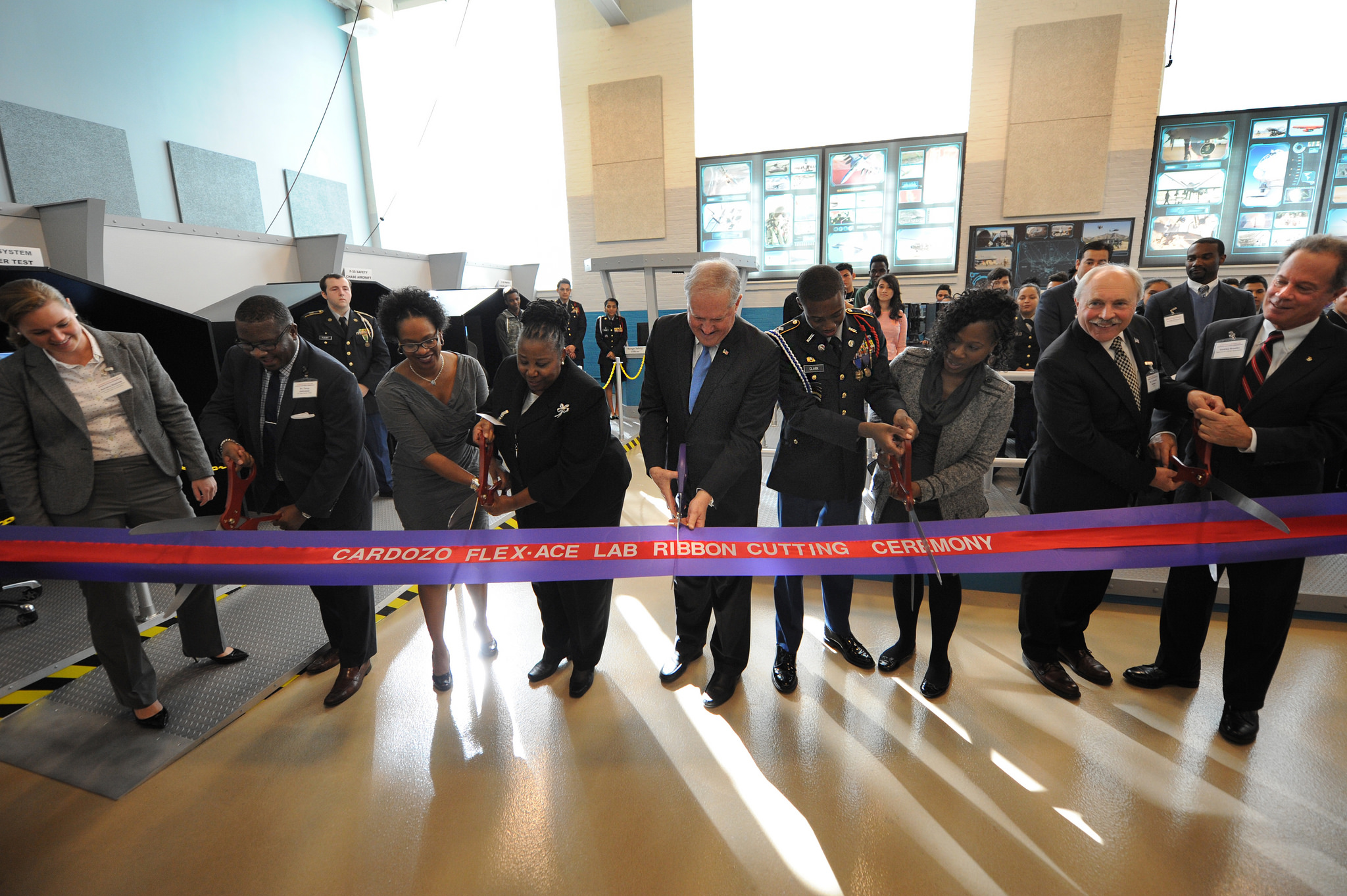By Cheryl Pellerin DoD News, Defense Media Activity
WASHINGTON, October 22, 2015 — The Defense Department is
making it possible for a local school here to turn an ordinary classroom into a
novel learning environment that engages students in a complex science, math and
technology curriculum.
Frank Kendall, undersecretary of defense for acquisition,
technology and logistics, spoke with students at the Cardozo Education Campus
this week and helped cut the ribbon to launch the Cardozo FLEX Lab Aviation
Classroom Experience, or FLEX-ACE.
Through a partnership with Cardozo, the DoD Test Resource
Management Center and the Office of the Assistant Secretary of Defense for
Research and Engineering supported the FLEX-ACE as part of their science,
technology, engineering and mathematics, or STEM, effort.
FLEX-ACE, developed by TEQGames, a learning and simulation
company based in Orlando, Florida, turned a high-ceilinged Cardozo classroom
into a test-and-evaluation, or T&E, lab featuring computer-based aviation
platforms and simulators that help DoD test distributed simulation environments
and improve students’ ability to learn, comprehend and retain new concepts.
’A Great Opportunity’
Attending the ceremony were defense officials, DoD STEM
partners, Cardozo administration and staff, and leaders from the District of
Columbia government and public schools. But when Kendall took the podium, he
spoke to the students.
“You've got a great opportunity here to take advantage of
the equipment, the interaction you'll have with others, the connection to other
laboratories -- the variety of things you can do here to open up things for
yourselves,” Kendall said.
The Cardozo FLEX-ACE classroom has three dual-pilot flight
simulators, an air-traffic-control tower, and nine remotely piloted vehicle
stations. The system lets students role-play in real-world missions that take
place at test ranges across the country and in local air space.
“This is a real distributed test lab, and the students are
emulating test operators,” said Dr. David Brown, deputy assistant secretary of
defense for developmental T&E, who attended the Cardozo ceremony. Brown is
also director of the department’s Test Resource Management Center.
According to TEQGames literature, students who participate
in the FLEX Lab experience “are challenged to new and engaging missions that
range from introductory flight experiences to survival-support operations from
the world’s most dangerous airport.”
Each mission requires critical thinking in applying core
math and science competencies ranging from time-speed-distance calculations to
advanced physics, TEQGames says.
Workforce Outreach
FLEX-ACE introduces students to technical and engineering
disciplines they might not otherwise be exposed to at the high school level,
and a range of career paths aligned with the DoD T&E mission.
The focus on science and technology is part of the DoD STEM
mission -- to attract, inspire and develop exceptional STEM talent across the
education continuum to enrich current and future service members and the DoD
workforce to meet defense technological challenges.
In March, Defense Secretary Ash Carter spoke about the
importance to the department of looking to the future.
“I’ve made a commitment to the men and women in uniform, to
President Obama and to the American people, that as secretary of defense I will
drive change to build what I call the Force of the Future: the military and the
broader Defense Department that we need to serve and defend our country in the
years to come,” the secretary said.
Persistent Pipeline
The DoD Test Resource Management Center also has a workforce
outreach goal -- to ensure that a persistent pipeline of technology adds to the
DoD technology T&E enterprise, and adds talent to the DoD T&E
community.
The workforce is DoD’s most valuable T&E resource, Brown
said.
The Cardozo FLEX-ACE lab is the first of its kind in
Washington, and although it is the 18th FLEX-ACE classroom across the country
and around the world, it is the third being used as a T&E
distributed-test-environment test bed.
The immersive laboratory environment puts students in
realistic T&E range occupations -- as engineers, scientists and
technologists. Through interactive T&E missions, students develop a strong
foundation in basic T&E concepts and an appreciation for the diverse career
field.
FLEX-ACE allows students to see themselves in these roles
and encourages their pursuit of challenging higher education, Brown said.
In his remarks to the students, Kendall recalled that he
went through school during the Space Age, when the nation was working to put
people on the moon.
“Think about that era, and today there are some interesting
parallels,” he said. “Many areas of technology are opening up now too in
aerospace and space.”
Emerging Technologies
Hypersonic flight is an emerging technology, and Kendall
mentioned the record-breaking final flight of the Air Force’s X-51A hypersonic
scramjet, which in May 2013 reached Mach 5.1.
An aircraft speed is said to be hypersonic, according to
NASA, when it is greater than Mach 5, which is five times the speed of sound.
Typical speeds for hypersonic aircraft are greater than 3,000 miles per hour.
Flying speeds above Mach 5 for military and commercial
applications are on the horizon, Kendall said, “and we're going to get there.”
Amazing things are happening in space, he told the students.
“Commercial companies like Google are talking about using
massive constellations to provide Internet everywhere, all the time, to
everybody,” he said, and for Earth observation and communications in general.
“Manned space flight will come back in a big way,
eventually,” Kendall said. “We're going to get beyond the space station, and
NASA's serious about going to Mars. There are enormous opportunities out
there.”
Kendall encouraged the students to get started now.
“Make the choice to dig into this and learn as much as you
can,” he told them. “It will serve you enormously well.”








No comments:
Post a Comment